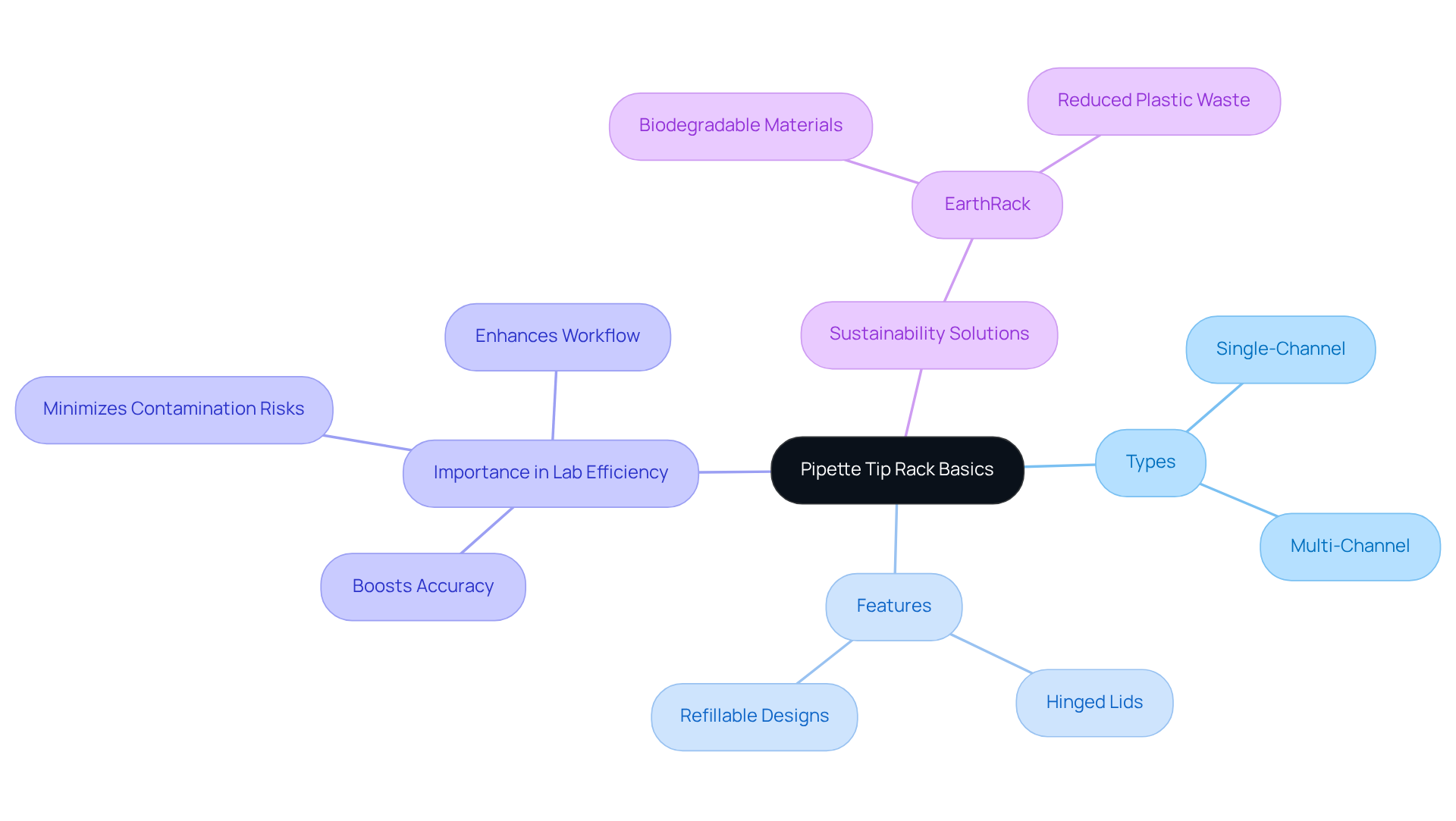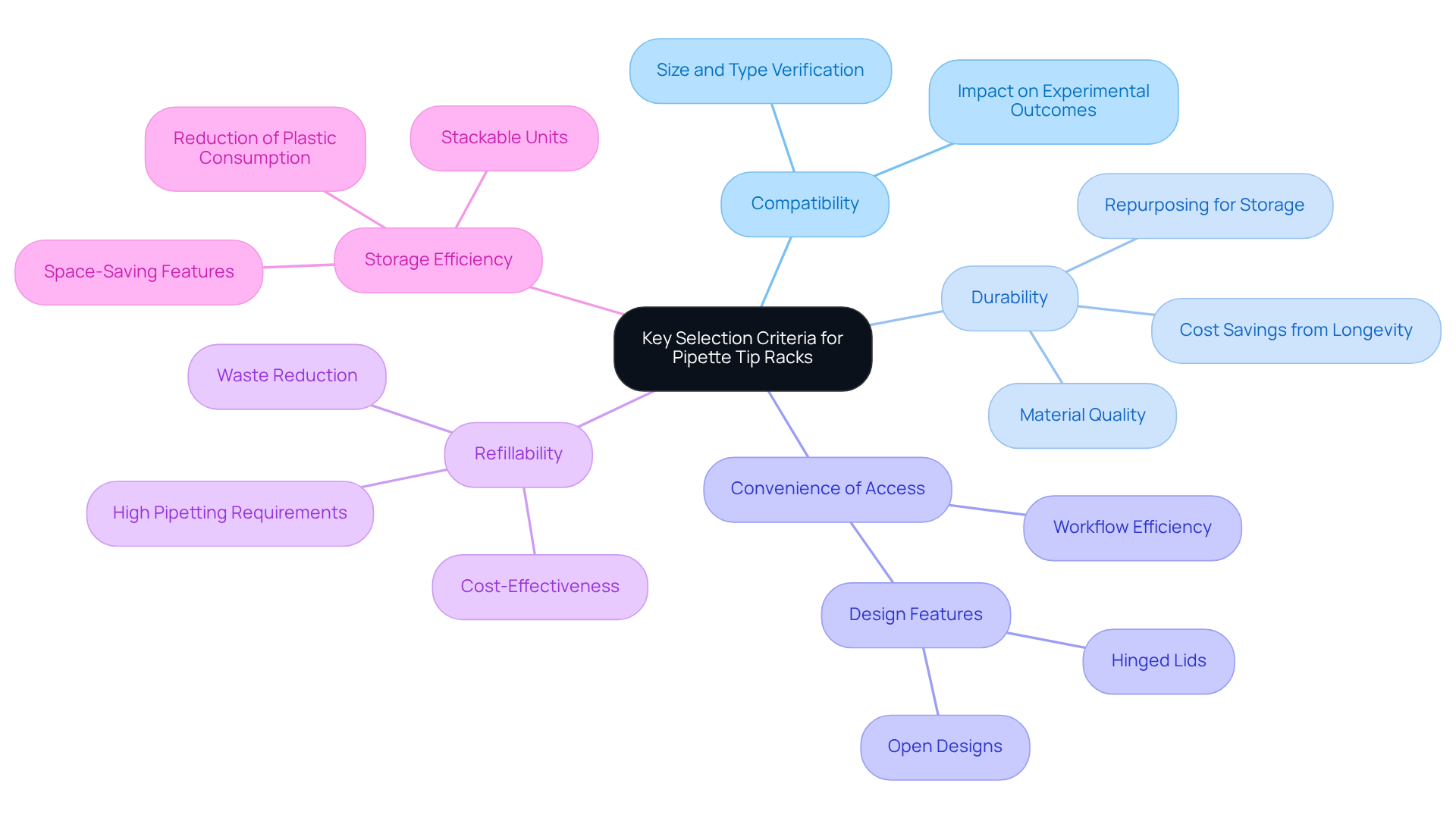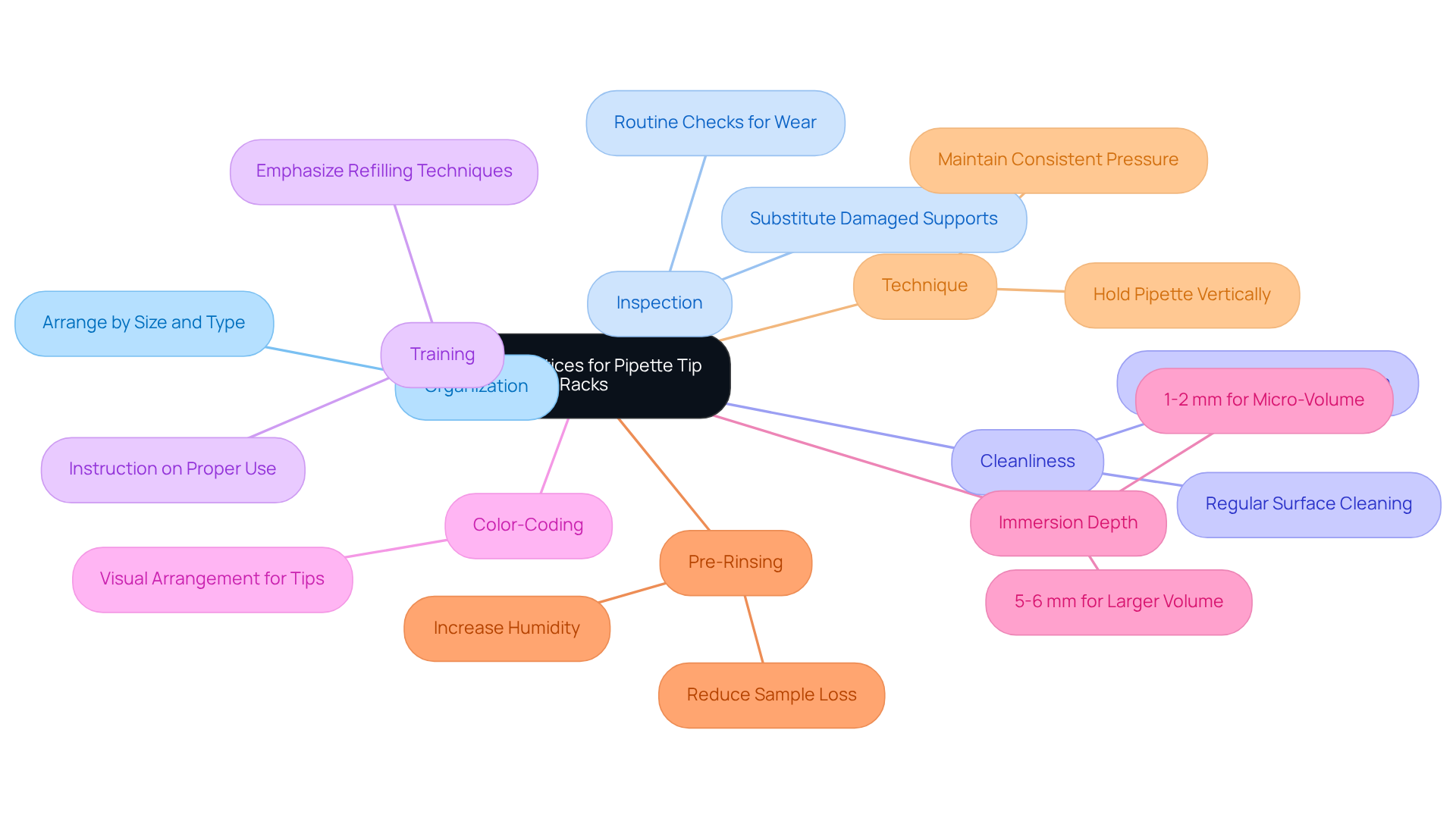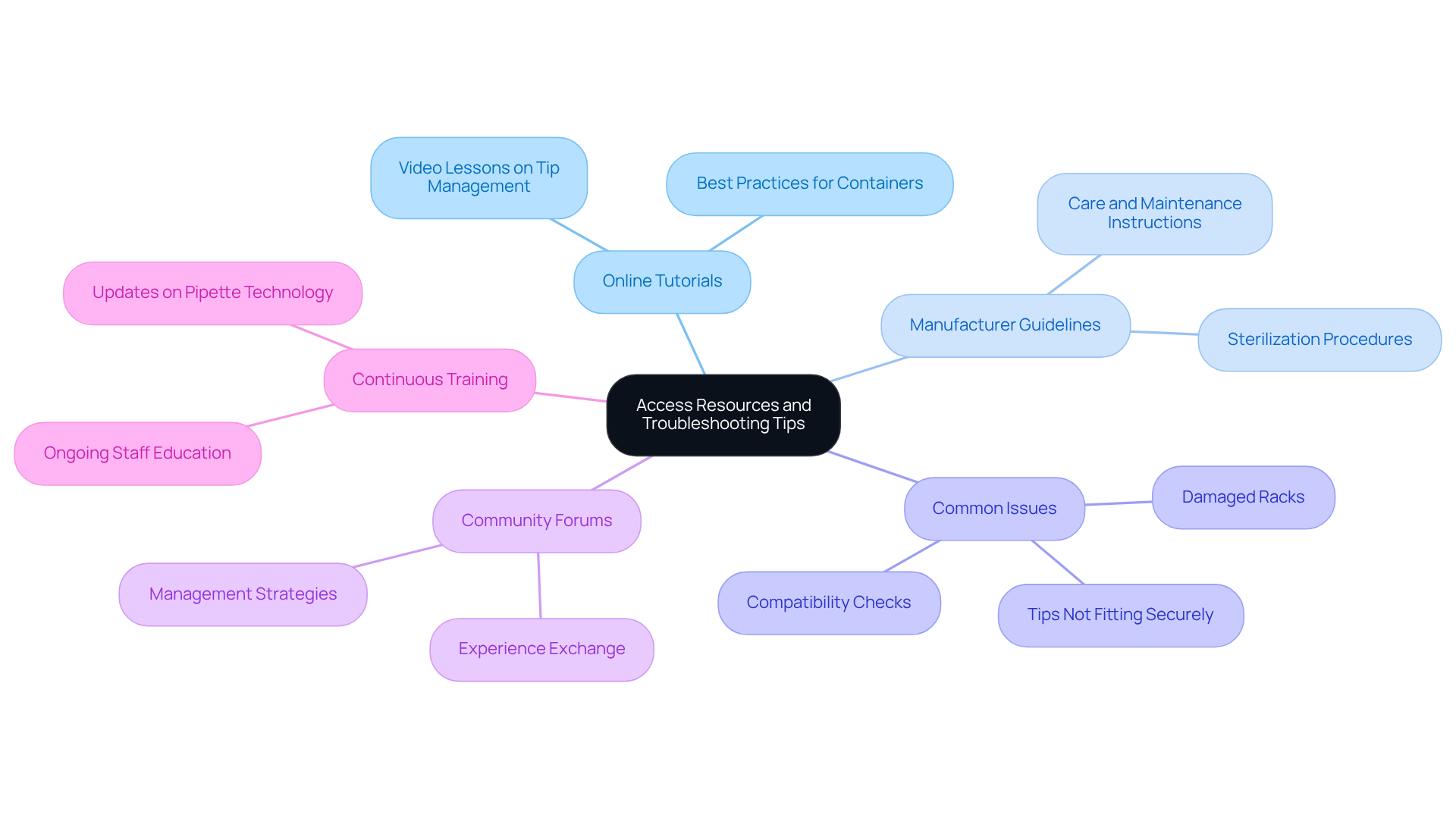Overview
Mastering pipette tip racks is crucial for lab managers aiming to boost laboratory efficiency and sustainability. This article delineates essential selection criteria, including:
- Compatibility
- Durability
- Organization
It emphasizes best practices and eco-friendly options that significantly enhance accuracy while minimizing waste in laboratory environments. By understanding these factors, lab managers can make informed decisions that not only improve workflow but also contribute to a sustainable future in scientific research.
Introduction
Pipette tip racks stand as pivotal components in laboratory efficiency, serving a crucial function in the organization and accessibility of pipette tips. For lab managers, grasping the nuances of these indispensable tools is essential; selecting the right rack can notably enhance workflow and precision while simultaneously addressing sustainability concerns. Given the plethora of options available, one must consider how to navigate the complexities of choosing the ideal pipette tip rack. This selection process should not only cater to the specific requirements of their facility but also strive to minimize environmental impact.
Understand Pipette Tip Rack Basics
Pipette tip racks stand as essential instruments in research settings, expertly designed to securely support and organize pipette tips. These holders come in various configurations, including single-channel and multi-channel options, typically crafted from durable plastic materials that withstand the rigors of daily laboratory use. Features such as hinged lids and refillable designs significantly enhance laboratory workflows, allowing for easy access while minimizing contamination risks during experiments. Understanding the diverse types of supports that accommodate different tip sizes and types is crucial for selecting the most suitable option for your facility's specific needs.
Effective organization of tip containers not only boosts efficiency but also ensures accuracy in experimental results. This makes the choice of the appropriate rack a pivotal consideration for any lab manager. Notably, 80% of plastic waste generated by research facilities at MIT originates from tip boxes, underscoring the pressing need for effective tip organization and waste reduction in laboratory environments. As one laboratory manager aptly stated, "Precision and accuracy are essential to any lab experiment," which underscores the critical importance of proper tip management.
Furthermore, innovative designs such as EarthRack, made from biodegradable materials, contribute to reducing plastic waste, further emphasizing the environmental impact of selecting the right tip storage solutions. By prioritizing effective organization and eco-friendly options, laboratories can enhance their operational efficiency while also addressing sustainability concerns.

Evaluate Key Selection Criteria for Pipette Tip Racks
When selecting pipette tip racks, prioritizing several key criteria is essential to ensure optimal laboratory efficiency and sustainability.
-
Compatibility is crucial; verify that the shelves are suitable for the specific pipette accessories employed in your laboratory. This involves confirming the size and type of tips that fit securely within the holder. Mismatches can lead to inefficiencies and inaccuracies in pipetting tasks, which can compromise experimental outcomes.
-
Durability is another essential factor. Choose shelves made from premium materials that can withstand frequent use and sterilization methods, including autoclaving. Durable shelves not only endure the challenges of laboratory settings but also contribute to long-term cost savings by decreasing the necessity for regular replacements. Moreover, durable plastic boxes can often be repurposed for storage, enhancing their utility in the lab.
-
Convenience of Access is vital for maintaining a smooth workflow. Opt for shelves designed for straightforward retrieval of tools, which reduces the time spent obtaining them during experiments. Features such as hinged lids or open designs can significantly enhance usability, allowing for a more efficient laboratory environment.
-
Refillability should also be considered. Refillable shelves help reduce waste and are cost-effective over time. Storage refill systems allow users to load tips into existing holders, minimizing the buildup of vacant supports and containers. This feature is especially beneficial for facilities with high pipetting requirements, as it permits the ongoing use of current pipette tip racks without the need for additional plastic packaging.
-
Finally, assess the Storage Efficiency of the shelving unit. Evaluate the design for space-saving features, particularly in settings with limited bench space. Stackable units decrease plastic consumption by allowing five units to be substituted with one stackable item, thereby enhancing storage efficiency and promoting sustainability.
By focusing on these criteria, laboratory managers can make informed decisions that enhance operational efficiency and sustainability in their pipetting practices.

Implement Best Practices for Using Pipette Tip Racks
To maximize the effectiveness of pipette tip racks, adhering to best practices that enhance accuracy and efficiency in liquid handling is essential.
-
Organize pipette tip racks by size and type: Arrange pipette tips in holders according to their size and type. This organization streamlines the pipetting process and minimizes the risk of errors, thereby enhancing overall accuracy in liquid handling.
-
Regularly Inspect Racks: Conduct routine inspections for signs of wear or damage. Quickly substitute any damaged or compromised supports to ensure a safe and dependable working environment.
-
Maintain Cleanliness: Keep shelves clean and free from contaminants. Regularly wipe down surfaces with suitable cleaning solutions to prevent cross-contamination, which can adversely affect experimental results.
-
Train Staff: Provide extensive instruction for all laboratory personnel on the correct use and handling of pipette tip racks. Emphasizing the importance of correct refilling techniques and maintaining organization is crucial for enhancing operational efficiency.
-
Utilize Color-Coding: Implement a color-coding system for various types of suggestions or racks. This visual arrangement aids in swiftly recognizing the appropriate advice, thereby decreasing the chances of mistakes during experiments.
-
Follow Immersion Depth Guidelines: Ensure that liquid handling instruments are submerged properly—1-2 mm for micro-volume devices and 5-6 mm for larger volume instruments—to attain precise results.
-
Pre-Rinse Tips: Pre-rinsing new tips before use can increase humidity and reduce sample loss due to evaporation, thereby improving accuracy.
-
Emphasize Proper Technique: Train staff to hold the instrument vertically during aspiration to prevent sample loss due to surface tension effects.
By following these best practices, laboratories can significantly improve pipetting accuracy and efficiency, ultimately leading to more reliable experimental outcomes.

Access Resources and Troubleshooting Tips
To enhance your understanding and management of pipette tip racks, consider these essential resources and troubleshooting tips:
- Online Tutorials: Leverage internet platforms that offer video lessons on tip management and best practices for utilizing containers effectively. These tutorials can provide practical insights that are crucial for optimal performance.
- Manufacturer Guidelines: Always refer to the manufacturer's instructions for specific directions on the care and maintenance of pipette tip racks, including sterilization procedures. Adhering to these guidelines ensures longevity and reliability in your equipment.
- Be vigilant about common issues, such as tips not fitting securely in pipette tip racks or the racks becoming damaged. Address these by ensuring compatibility and conducting regular inspections for wear, which can prevent costly disruptions in your workflow.
- Community Forums: Engage with management forums or communities where you can exchange experiences and solutions with other managers facing similar challenges. This collaborative approach fosters a deeper understanding of effective management strategies.
- Continuous Training: Invest in ongoing training for laboratory staff to keep them informed about best practices and new developments in pipette technology and management. This commitment to education not only enhances skill sets but also promotes a culture of excellence in your laboratory.

Conclusion
Selecting the right pipette tip rack transcends mere convenience; it is a strategic decision that can profoundly impact laboratory efficiency and sustainability. By grasping the essential features and best practices associated with pipette tip racks, lab managers can make informed choices that enhance workflow, uphold accuracy, and mitigate environmental impact.
Key considerations—such as compatibility, durability, accessibility, refillability, and storage efficiency—are crucial in identifying the most appropriate pipette tip racks for any laboratory. Furthermore, implementing best practices—such as organizing racks by size, conducting regular inspections, and training staff—ensures that these tools are utilized effectively, ultimately leading to more reliable experimental outcomes.
Given the urgent demand for sustainability in laboratory environments, prioritizing eco-friendly options and efficient organization can yield significant benefits. By adopting these principles, laboratory managers not only enhance operational efficiency but also contribute positively to environmental stewardship. Dedicating time to understand and apply these strategies will undeniably foster a more organized, efficient, and responsible laboratory setting.




